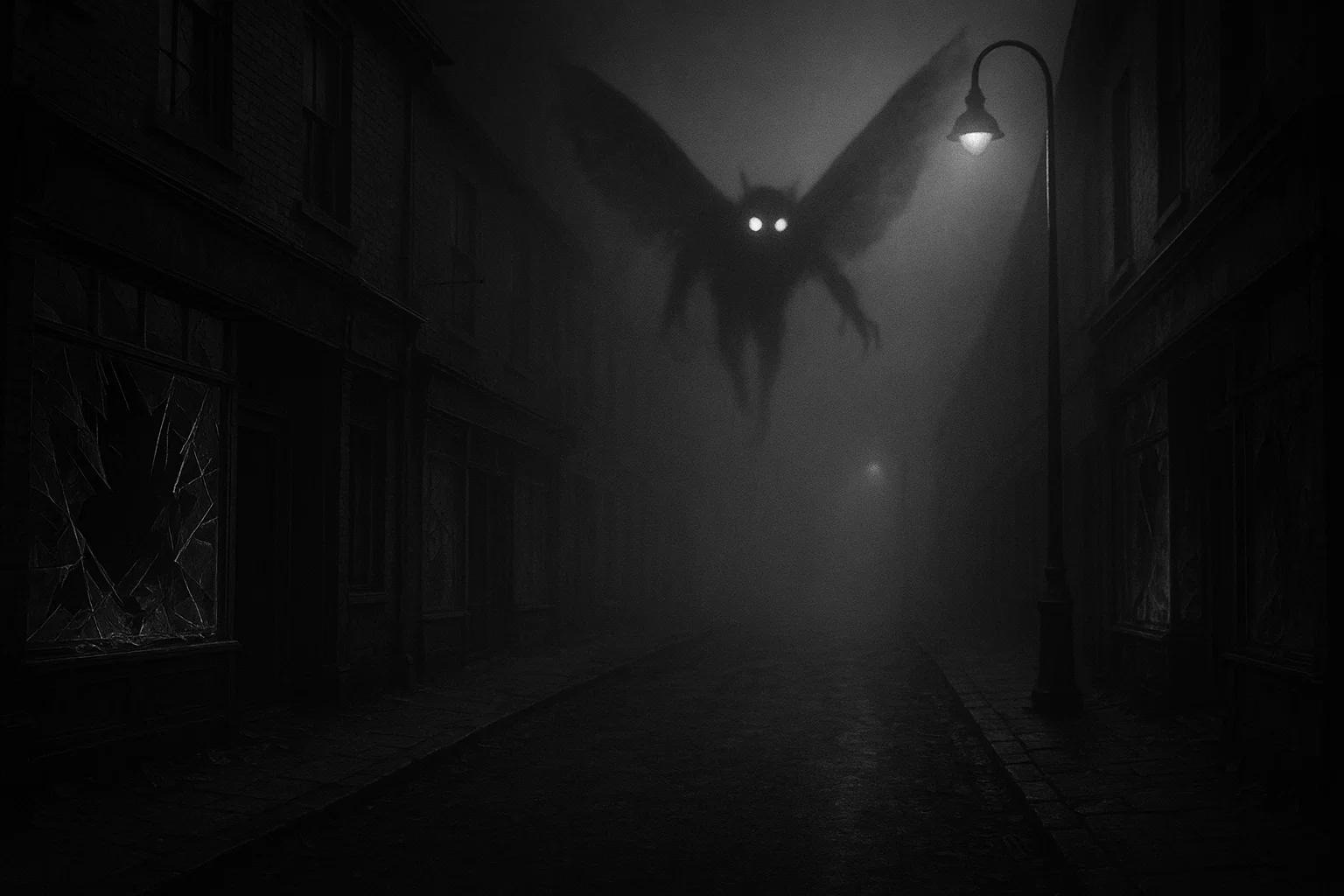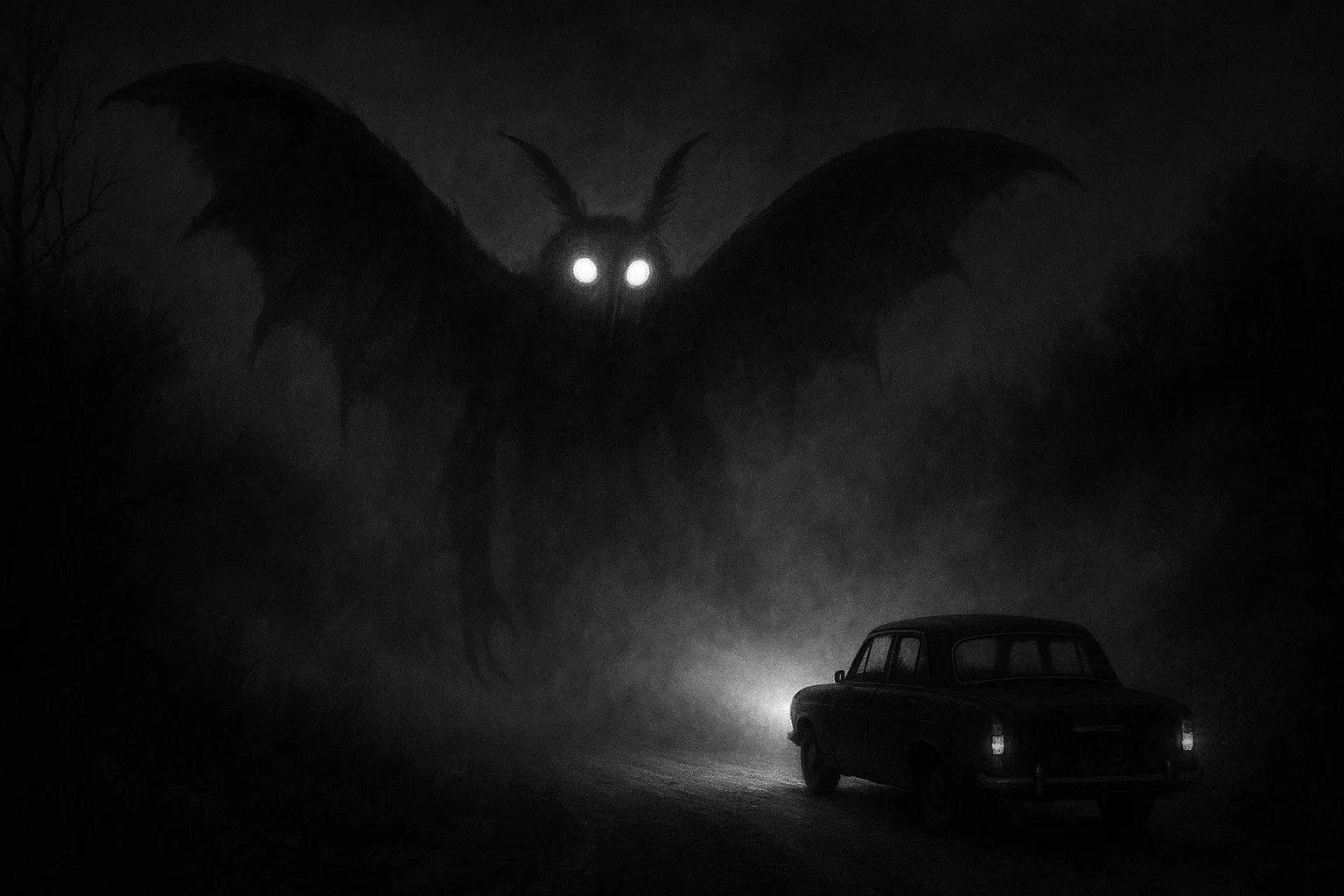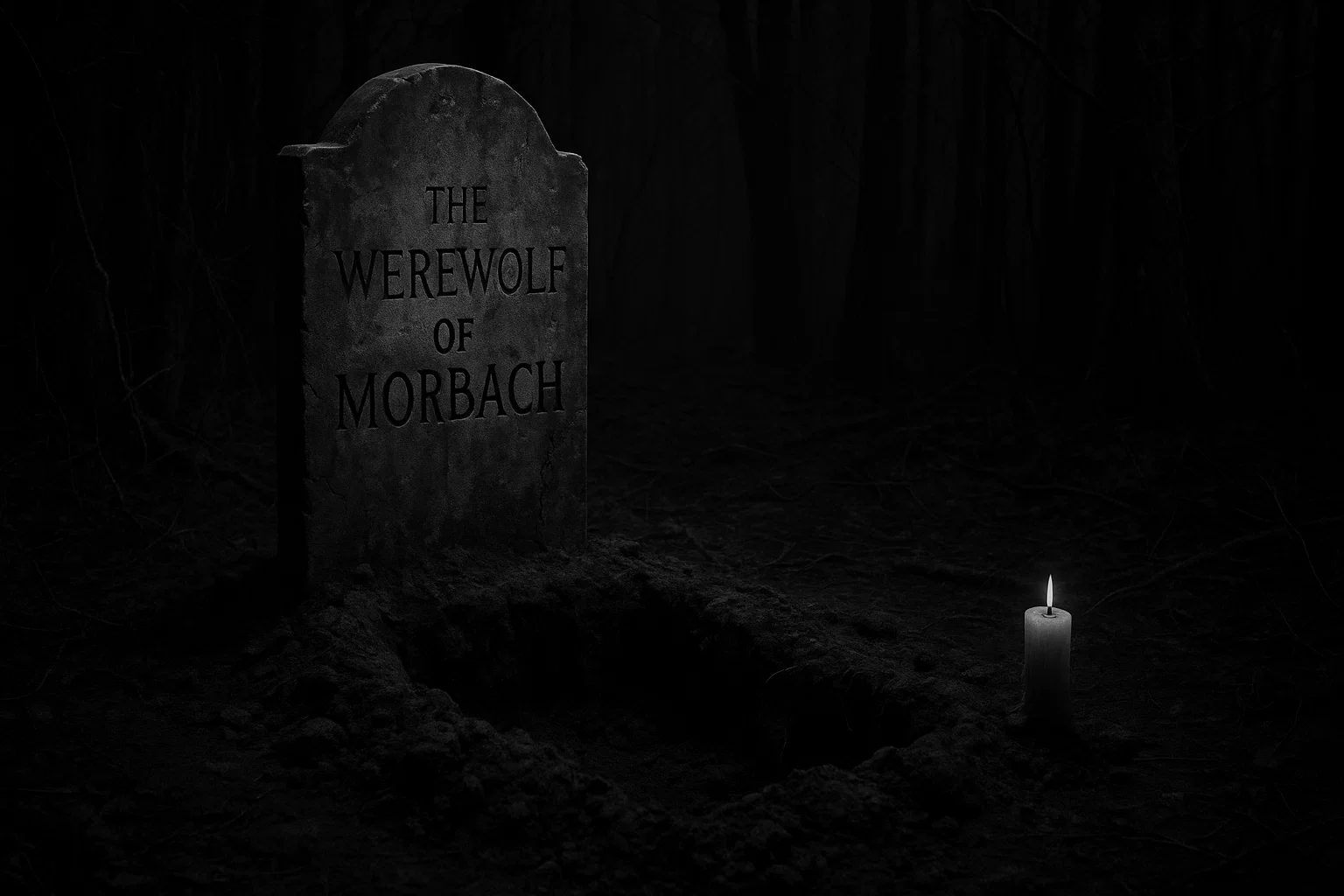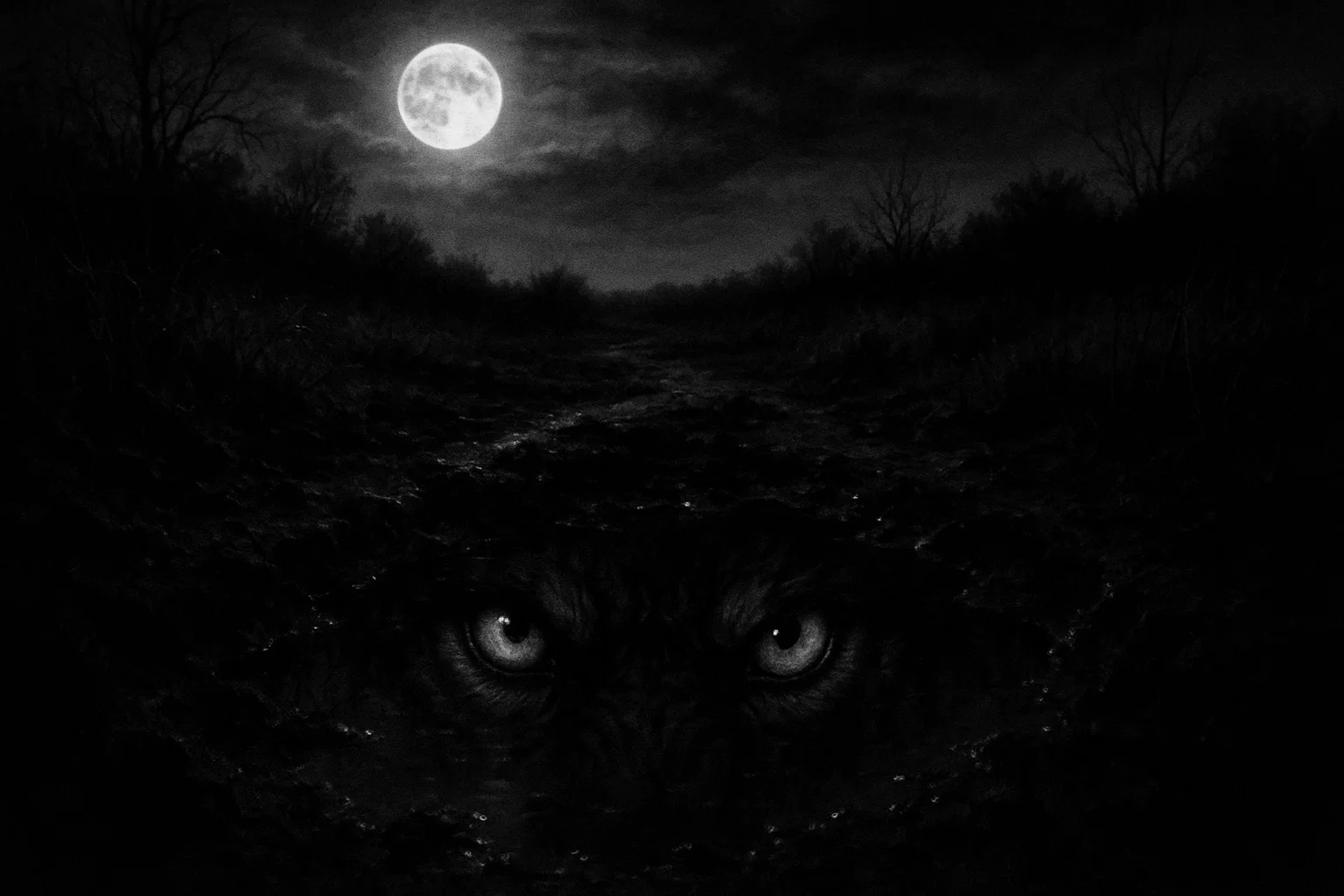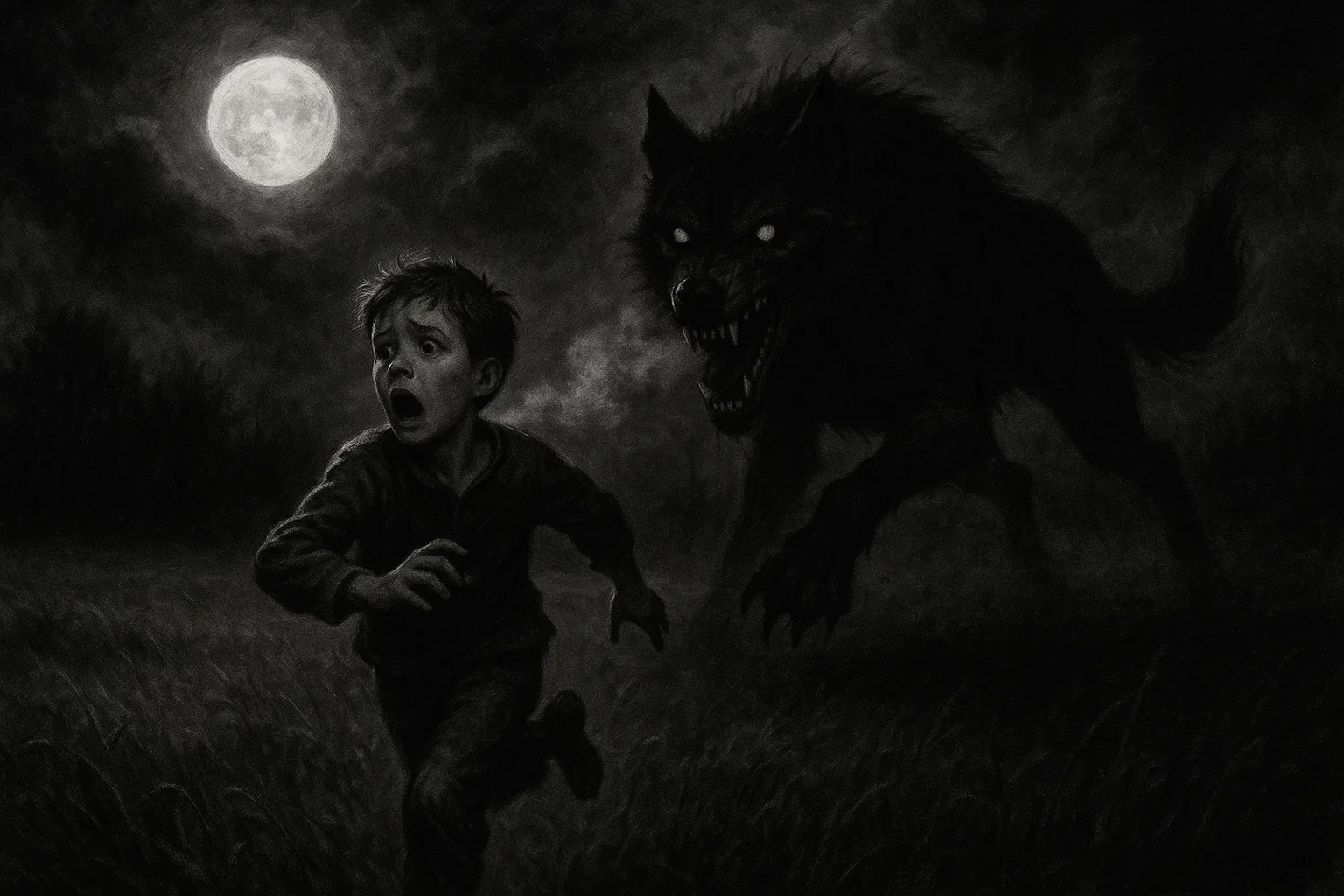Deep in the heart of West Virginia, a chilling legend was born in the 1960s, captivating the imaginations of locals, researchers, and thrill-seekers alike.
The Mothman, a winged humanoid with piercing red eyes, emerged from the shadows of Point Pleasant, sparking tales of terror, prophecy, and the unexplained.
This cryptid, shrouded in mystery, is tied to eerie sightings, paranormal phenomena, and the tragic collapse of the Silver Bridge in 1967. What is the Mothman—a creature of flesh and blood, a supernatural harbinger, or a product of fear and folklore?
Table of Contents
What Is the Mothman?
The Mothman is a cryptid, a creature whose existence remains unproven by science yet is deeply embedded in American folklore. First sighted in Point Pleasant, West Virginia, on November 15, 1966, it is described as a towering, winged humanoid with glowing red eyes that radiate an unsettling intensity.
The name “Mothman” was coined by a local newspaper, the Point Pleasant Register, following a dramatic encounter by two young couples.
The creature’s legend grew rapidly, fueled by over 100 reported sightings in the region between 1966 and 1967. Many witnesses claimed the Mothman appeared before disasters, earning it a reputation as an omen of doom. Its association with the Silver Bridge collapse, which killed 46 people, cemented its status as a harbinger in local lore.
Beyond its physical presence, the Mothman is steeped in cultural significance. Point Pleasant hosts the annual Mothman Festival, drawing thousands to celebrate the legend through art, tours, and storytelling.
A 12-foot stainless-steel statue of the creature, erected in 2003, stands as a testament to its enduring impact. The Mothman Museum, opened in 2005, preserves artifacts, eyewitness accounts, and newspaper clippings, offering a glimpse into the phenomenon’s history.
Some researchers link the Mothman to extraterrestrial activity, citing concurrent UFO sightings, while others view it as a psychological manifestation of Cold War-era anxieties.
Regardless of its origins, the Mothman remains a symbol of the unknown, blending fear, fascination, and folklore.
What Does the Mothman Look Like?
Witness descriptions paint a vivid picture of the Mothman as a formidable and eerie creature.
Standing 6 to 7 feet tall, it possesses a wingspan of 10 to 15 feet, allowing it to glide or hover with uncanny agility. Its most striking feature is its large, glowing red eyes, approximately 2 inches in diameter and spaced 6 inches apart, which seem to mesmerize onlookers.
The creature’s body is slender yet muscular, covered in light-grey or brownish skin that some compare to moth-like fuzz.
Unlike bats, its wings lack visible membranes, appearing more avian or angelic, though feathers are rarely mentioned. Witnesses note its ability to fly at speeds up to 100 mph, ascend vertically like a helicopter, and produce a distinct flapping or screeching sound.
Particularities include its avoidance of bright light, with its eyes glowing brighter when illuminated, suggesting a nocturnal nature.
Some accounts describe a lack of facial features beyond the eyes, while others mention a humanoid shape with no discernible head, as if the eyes are embedded in its torso.
The Mothman’s movements are described as both graceful and predatory, with reports of it perching on rooftops or chasing vehicles. Its physical form defies known biology, as no creature of its size and structure could fly under Earth’s physical laws, fueling speculation about its origins.
You May Also Like: The Forgotten Werewolf Case of Henry Gardinn
Habitat
The Mothman is most closely tied to Point Pleasant, West Virginia, specifically the TNT area, a 3,600-acre tract within the McClintic Wildlife Management Area.
This site, a former World War II munitions plant, is dotted with abandoned concrete bunkers, or “igloos,” used to store explosives. The area’s dense forests, wetlands, and proximity to the Ohio River create a secluded environment ideal for a creature that avoids human contact.
The TNT area’s terrain includes overgrown vegetation, small ponds, and a mix of deciduous trees, supporting wildlife like deer, foxes, and large birds such as sandhill cranes and barred owls.
The region’s isolation, combined with its history of chemical storage, has led to theories about environmental mutations, though no evidence supports this.
Point Pleasant, a small town of about 4,000 residents, sits at the confluence of the Ohio and Kanawha Rivers, fostering a mix of rural and industrial landscapes.
The TNT area’s abandoned structures, including a derelict power plant, are rumored to serve as the Mothman’s lair, with witnesses reporting sightings near these ruins.
Beyond Point Pleasant, sightings have occurred in other regions, such as Chicago, Illinois, in 2017, where over 50 reports described a similar winged creature in urban parks and near Lake Michigan. These urban sightings suggest the Mothman may adapt to varied environments, from wilderness to cityscapes.
The TNT area is also a hotspot for paranormal activity. During the 1960s, residents reported UFO sightings, strange lights, and encounters with “Men in Black,” mysterious figures allegedly investigating the Mothman.
Local legends speak of the Curse of Cornstalk, tied to a Shawnee chief executed in 1777, whose death supposedly cursed the land with misfortune. Some connect this curse to the Mothman and the Silver Bridge collapse.
Other cryptids, such as the Grafton Monster and Flatwoods Monster, have been reported in West Virginia, suggesting the state’s rugged terrain and folklore-rich culture may foster belief in strange creatures.
The TNT area’s history of secrecy, from wartime production to Cold War-era anxieties, adds a layer of intrigue, making it a focal point for unexplained phenomena.
You May Also Like: The Werewolf of Morbach: Truth or Terrifying Legend?
Mothman Sightings
The Mothman phenomenon began in November 1966 and peaked with over 100 reported sightings in West Virginia by December 1967.
| Date | Location | Witnesses | Description |
|---|---|---|---|
| November 12, 1966 | Clendenin, West Virginia | Kenneth Duncan, four others | Brown, winged humanoid flew low over cemetery at dusk; no glowing eyes noted. |
| November 14, 1966 | Salem, West Virginia | Newell Partridge | Saw red lights in field; dog chased them, never returned; TV interference reported. |
| November 15, 1966 | Point Pleasant, West Virginia (TNT area) | Roger and Linda Scarberry, Steve and Mary Mallette | 7-foot creature with 10-foot wingspan, glowing red eyes chased car at 100 mph. |
| November 16, 1966 | Point Pleasant, West Virginia (Route 62) | Thomas Ury | Grey creature with red eyes circled car, flew toward Ohio River in daylight. |
| November 17, 1966 | Cheshire, Ohio | Teenager (anonymous) | Saw winged figure with red eyes near Ohio River; reported to local police. |
| November 24, 1966 | Point Pleasant, West Virginia | Four teenagers | Saw creature with glowing eyes near TNT area; fled in fear. |
| November 27, 1966 | New Haven, West Virginia | Connie Carpenter | 7-foot grey figure with red eyes followed car in daylight; hypnotic gaze. |
| December 4, 1966 | Gallipolis, Ohio | Everett Wedge, four pilots | Bird-like man with 10-foot wingspan flew at 70 mph without flapping wings. |
| December 6, 1966 | Point Pleasant, West Virginia | Ruth Foster | Winged figure with red eyes perched on Silver Bridge at night. |
| December 11, 1966 | Point Pleasant, West Virginia | Multiple residents | Various reports of creature near Silver Bridge before collapse. |
| April 2017 | Chicago, Illinois (Lake Michigan) | Multiple witnesses | Winged humanoid with red eyes seen in parks and near lake; over 50 reports. |
Below is a detailed examination of the six most significant and well-documented sightings, followed by a comprehensive table of all known encounters.
November 12, 1966: Clendenin Cemetery Sighting
On November 12, 1966, five gravediggers working in a cemetery near Clendenin, West Virginia, 60 miles from Point Pleasant, witnessed a startling event. Around dusk, they saw a “brown human being” with wings lift off from nearby trees and fly low over their heads.
The men, including Kenneth Duncan, described the creature as humanoid yet bird-like, with no glowing eyes mentioned.
This sighting, reported to local police, marked the first documented Mothman encounter, setting the stage for the wave of sightings that followed.
November 15, 1966: TNT Area Encounter
The most famous Mothman sighting occurred on November 15, 1966, in the TNT area. Roger and Linda Scarberry, along with Steve and Mary Mallette, were driving near the abandoned munitions plant when they spotted a 7-foot-tall creature with a 10-foot wingspan and glowing red eyes.
The creature chased their car at speeds up to 100 mph, emitting a high-pitched screech. The couples reported the incident to the Mason County Sheriff, and it appeared in the Point Pleasant Register the next day, headlined “Couples See Man-Sized Bird … Creature … Something.”
This event sparked widespread media attention and public fascination.
November 16, 1966: Thomas Ury’s Roadside Encounter
On November 16, 1966, Thomas Ury, a salesman, was driving along Route 62 near the TNT area at 7:15 a.m. when he saw a large, grey creature with red eyes rise from a field.
It circled his car before flying toward the Ohio River. Ury, shaken, reported the sighting to police, describing the creature’s wings as non-feathered and its flight as eerily silent.
This daytime sighting added credibility, as it occurred in clear conditions and involved a single, reliable witness.
November 27, 1966: Connie Carpenter’s Daytime Sighting
Connie Carpenter, a 19-year-old from New Haven, West Virginia, encountered the Mothman on November 27, 1966, while driving home from church.
Near Mason, she saw a 7-foot-tall, grey figure with a 10-foot wingspan and glowing red eyes standing by the road. The creature took flight, following her car briefly before veering off.
Carpenter’s account, reported to local authorities, was notable for its daytime clarity and her description of the creature’s hypnotic gaze, which left her deeply unsettled.
You May Also Like: What Is the Kongamato? Africa’s Mysterious Winged Creature
December 4, 1966: Ohio River Sighting
On December 4, 1966, five pilots at the Gallipolis, Ohio, airport, across the river from Point Pleasant, observed a winged creature flying at high speed.
Described as a “bird-like man” with a 10-foot wingspan, it moved at an estimated 70 mph without flapping its wings.
The pilots, including Everett Wedge, reported the sighting to the Federal Aviation Administration, noting the creature’s greyish color and lack of glowing eyes in daylight.
This sighting reinforced the Mothman’s presence beyond West Virginia.
December 1967: Silver Bridge Premonition
In the days before the Silver Bridge collapse on December 15, 1967, multiple residents reported seeing the Mothman near the structure.
Witnesses, including local shopkeeper Ruth Foster, described a winged figure with red eyes perched on the bridge’s railings at night. These sightings fueled speculation that the Mothman was warning of the impending disaster, which killed 46 people when the bridge failed due to a structural defect.
The abrupt cessation of sightings after the collapse deepened the creature’s mystique.
Evidence, Investigations, and Theories
Evidence
Physical evidence for the Mothman is scarce, relying heavily on eyewitness testimonies and media reports. Over 100 accounts from 1966–1967 describe consistent features: a tall, winged humanoid with glowing red eyes.
A 2016 photograph from Mason County, West Virginia, showed a winged figure, but experts identified it as likely an owl carrying prey, possibly a snowy owl or barred owl.
A mounted snowy owl, killed in 1966 and displayed at the Mothman Museum, is cited as a possible source of misidentification due to its size and reflective eyes.
Other evidence includes reported electrical disturbances, such as TV static during Newell Partridge’s 1966 sighting, and strange lights in the TNT area.
Hoaxes, like construction workers tying flashlights to balloons, were confirmed in some cases, but they don’t account for all reports.
Investigations
Journalist John Keel conducted the most extensive investigation, detailed in his 1975 book The Mothman Prophecies. Keel interviewed dozens of witnesses, linking the Mothman to UFOs, Men in Black, and other paranormal events.
Local authorities, including Sheriff George Johnson, investigated early sightings but found no physical traces, such as footprints or feathers. The Mothman Museum, founded by Jeff Wamsley, houses artifacts like newspaper clippings, police reports, and witness sketches, preserving the legend’s history.
In Chicago, the 2017 sightings prompted amateur investigations by groups like the Chicago Mothman Research Team, though no conclusive evidence emerged. Skeptics, including geologist Sharon Hill, argue that most evidence points to natural explanations.
Theories
Misidentified Birds
The leading scientific theory, supported by Dr. Robert L. Smith and Joe Nickell, posits that the Mothman is a misidentified bird, such as a sandhill crane (4–5 feet tall, 7-foot wingspan, reddish eye markings) or barred owl (reflective red eyes in light).
These birds inhabit West Virginia and match the creature’s size, flight, and nocturnal habits. The crane’s awkward, humanoid stance when grounded could explain the “man-like” descriptions.
However, the reported 100-mph speed, vertical ascent, and lack of feathers in many accounts don’t align with known avian biology, weakening this theory for some sightings.
Likelihood: High, as it explains most physical traits and is grounded in known species. Limitations: Fails to account for extreme speed and consistent humanoid shape.
You May Also Like: Crowing Crested Cobra: A Real-Life Basilisk or Folklore Beast?
Hoaxes and Pranks
Skeptics like Jan Harold Brunvand suggest that media hype and local pranks fueled the Mothman craze. Confirmed hoaxes, such as flashlights tied to balloons, explain some sightings, particularly those involving strange lights.
The 1960s cultural fascination with UFOs and monsters may have encouraged embellishment. However, the volume of consistent, independent reports—many from credible witnesses like pilots and police officers—challenges the idea that all sightings were fabricated.
Likelihood: Moderate, as hoaxes are documented but don’t explain all accounts. Limitations: Consistency across unrelated witnesses suggests genuine experiences.
Supernatural or Extraterrestrial Entity
John Keel proposed that the Mothman is an ultraterrestrial or interdimensional being, possibly linked to UFOs or other dimensions. This theory ties the creature to concurrent UFO sightings, strange lights, and Men in Black reports in Point Pleasant.
Some witnesses described telepathic sensations or dread, supporting a supernatural origin. However, the lack of physical evidence and the improbability of a large, winged creature flying (per the square-cube law) make this theory speculative. The association with the Silver Bridge collapse adds intrigue but lacks causal proof.
Likelihood: Low, due to reliance on unprovable claims. Limitations: No physical evidence; flight defies physics.
Psychological Phenomena
Theories of mass hysteria or pareidolia suggest that sightings were influenced by cultural fears, such as Cold War anxieties or UFO mania. The Mothman’s emergence coincided with heightened public interest in the paranormal, potentially shaping perceptions.
Psychological factors could explain why ambiguous stimuli, like a large bird in low light, were interpreted as a monster. However, the detailed, consistent descriptions from diverse witnesses, including those unfamiliar with the legend, suggest more than collective delusion.
Likelihood: Moderate, as psychological factors likely played a role. Limitations: Doesn’t fully explain specific, consistent details across sightings.
Most Likely Theory
The misidentified bird theory is the most plausible, given the presence of large birds like sandhill cranes and barred owls in West Virginia, whose features align closely with witness descriptions.
The reflective eyes, large wingspan, and nocturnal behavior match known species, and misidentification is common in low-light conditions. While hoaxes and psychological factors likely amplified the phenomenon, the core sightings are best explained by natural causes. T
he supernatural theory, while intriguing, lacks empirical support and relies on speculative connections to UFOs and disasters.
You May Also Like: New Mokele-Mbembe Sightings, Theories & Evidence
Comparison with Other Similar Cryptids
The Mothman shares traits with other winged cryptids, each rooted in unique cultural and geographic contexts:
| Cryptid | Description | Location | Key Features |
|---|---|---|---|
| Owlman of Mawnan | Owl-like humanoid, 5–6 feet tall, feathered wings, clawed feet, glowing red eyes | Mawnan, Cornwall, UK | Hovers above church tower, linked to occult rituals |
| Jersey Devil | Kangaroo-like body, horse-like head, bat wings, horns, clawed hands, forked tail | Pine Barrens, New Jersey, USA | Emits a blood-curdling scream, tied to 18th-century curse |
| Thunderbird | Giant bird, 15–20 feet wingspan, dark feathers, sharp talons, glowing eyes | North America (Great Plains) | Creates thunder with wings, revered in Native lore |
| Ahool | Giant bat, 10–15 feet wingspan, grey fur, monkey-like face, large claws | Java, Indonesia | Nocturnal, emits “AH-OOooool” call, hunts fish |
| Orang-bati | Bat-like, 10-foot wingspan, reddish skin, black fur on wings, human-like face | Seram, Indonesia | Kidnaps children, lives in volcanic caves |
| Kongamato | Pterosaur-like, 4–7 feet wingspan, reddish skin, leathery wings, toothed beak | Zambia, Congo, Angola | Attacks boats, linked to pterodactyl sightings |
Is the Mothman Real?
The question of the Mothman’s reality remains a tantalizing mystery. Over 100 eyewitness accounts from 1966–1967, supported by consistent descriptions, suggest something extraordinary occurred in Point Pleasant.
Yet, the absence of definitive physical evidence—such as clear photographs, DNA, or remains—leans heavily toward skepticism. The misidentified bird theory, particularly involving sandhill cranes or barred owls, offers the most grounded explanation, supported by the region’s wildlife and the fallibility of human perception in low-light conditions.
Hoaxes and psychological factors, amplified by media frenzy and cultural anxieties, likely contributed to the legend’s spread. The supernatural narrative, while compelling, relies on unprovable claims and lacks scientific rigor.
The Mothman’s connection to the Silver Bridge collapse adds emotional weight, but official reports attribute the disaster to a structural flaw, not a cryptid’s warning.
Regardless of its existence, the Mothman has left an indelible mark on Point Pleasant, transforming a small town into a hub for cryptid enthusiasts.
The annual Mothman Festival, with its cosplay, tours, and lectures, and the Mothman Museum’s collection of artifacts keep the legend alive.
Whether a creature of flesh, a trick of the mind, or a messenger from beyond, the Mothman embodies humanity’s enduring quest to understand the unknown, leaving us to ponder: what lurks in the shadows of our world?

